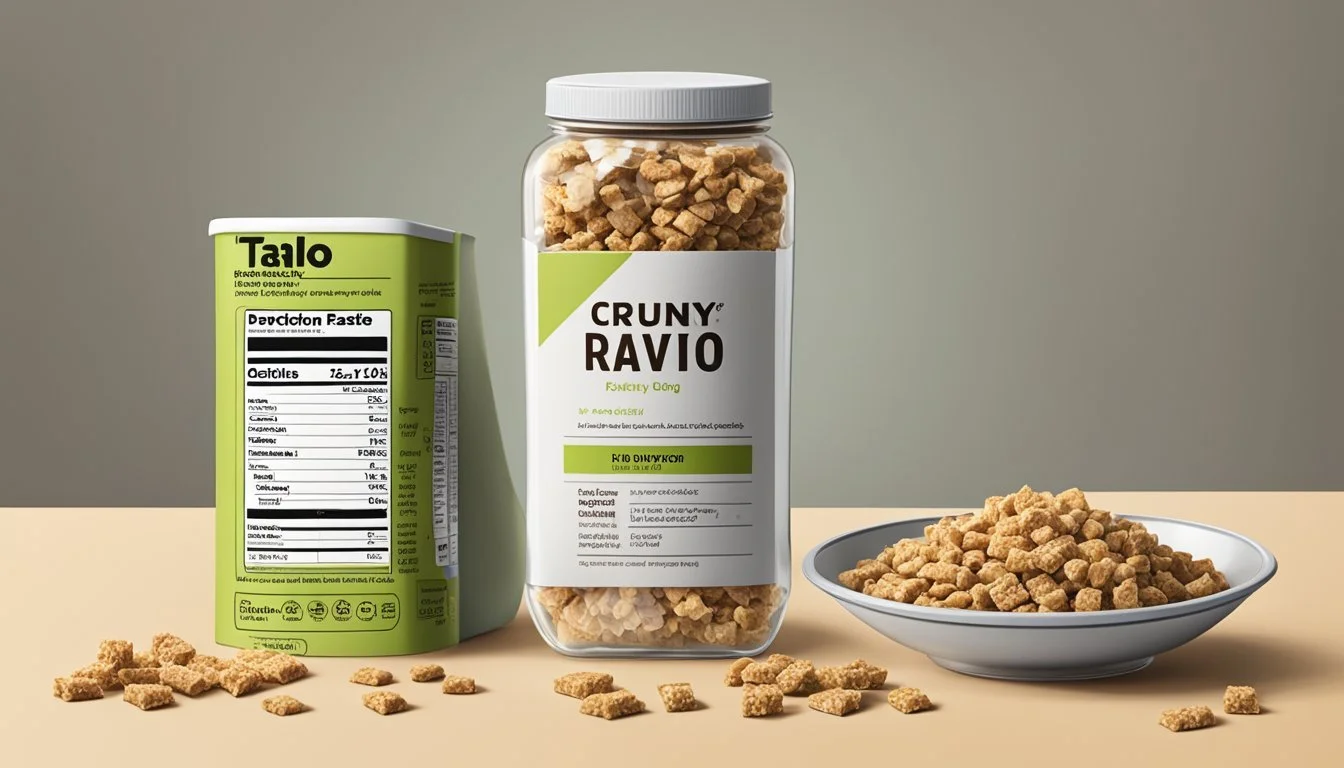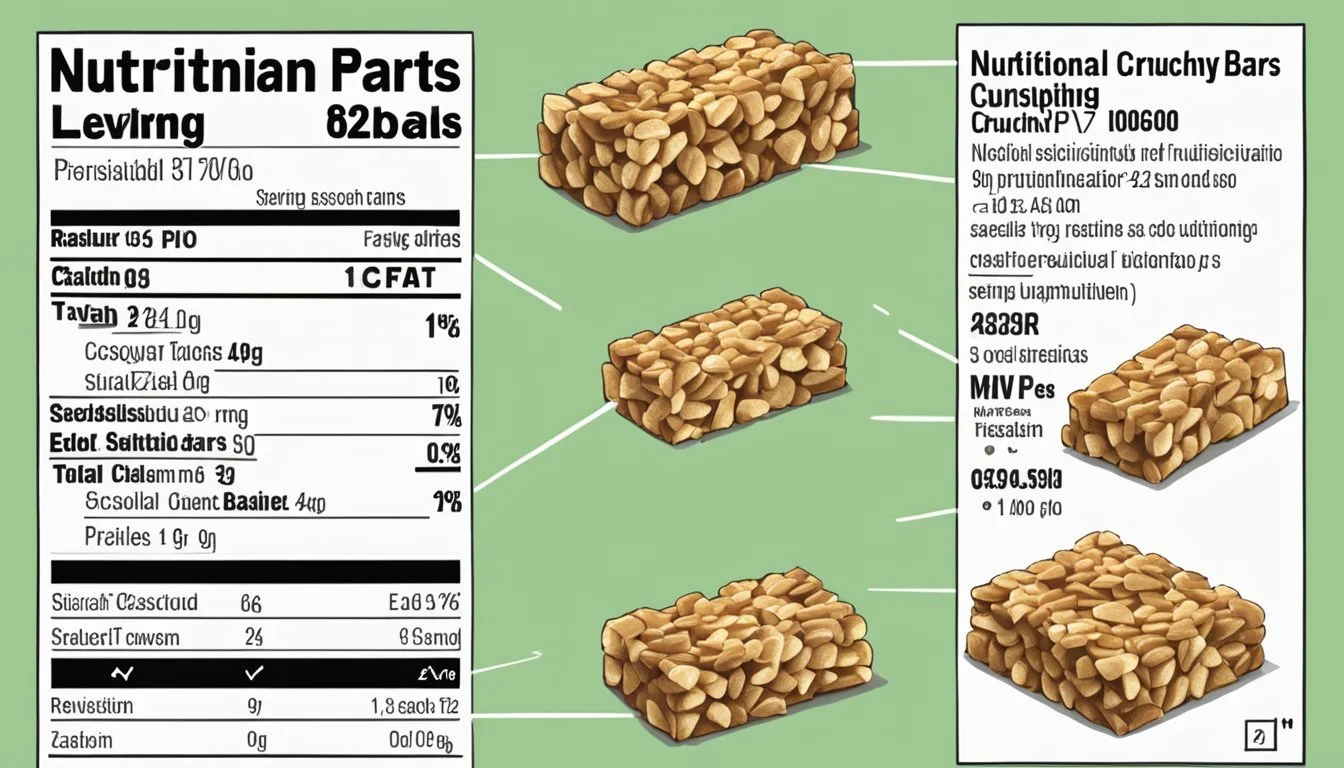How Many Servings of Ratio Crunchy Bars Is Too Much
Expert Guidance
When considering how many servings of Ratio Crunchy Bars is too much, it's important to look at the nutritional content of these bars. Each serving tends to contain around 17 grams of total fat, 2 grams of net carbohydrates, 12 grams of protein, and 1 gram of sugar. Depending on an individual's dietary needs and daily intake limits, consuming multiple bars might lead to excessive fat and calorie consumption.
For most adults, a suitable daily fat intake ranges between 44 to 77 grams, assuming a 2,000 calorie diet. Consuming more than three servings of Ratio Crunchy Bars could potentially exceed this range, especially if combined with other dietary fats. Additionally, while the carbohydrate content is low, the accumulated calories and fats from multiple servings should be considered to avoid overconsumption.
In sum, these bars provide a convenient source of protein and healthy fats, appealing to those on keto or low-carb diets. Readers interested in maintaining balanced nutrition should be mindful of consuming more than one or two servings daily, aligning their intake with personal health goals and nutritional guidelines.
Understanding Servings and Portions
When it comes to managing intake, understanding the difference between servings and portions is crucial. It helps ensure balanced nutrition and enables better decision-making.
Determining Serving Size
A serving size is a standardized amount of food defined by nutritional guidelines or food manufacturers. For instance, one serving of pasta is typically 1/2 cup cooked. In contrast, a serving of lean meat or fish is about the size of a deck of cards.
Knowing these standard serving sizes helps individuals gauge how much they consume relative to recommendations. This is particularly useful with pre-packaged foods where serving sizes are listed on the nutritional label. By comparing these standards to what one actually eats, better portion control can be achieved.
Interpreting Daily Values
Daily Values (DVs) are reference amounts of nutrients to consume or not to exceed each day. These values are usually expressed as percentages on nutritional labels. For example, eating a bar with 15% of the DV for protein means it provides 15% of the recommended daily intake for protein.
Interpreting DVs allows for better alignment with personal health goals. It provides context for understanding how individual foods contribute to the diet as a whole. When combined with knowledge of serving sizes, individuals can make informed dietary choices, ensuring they meet but do not exceed their nutritional needs.
Nutritional Profile of Ratio Crunchy Bars
Ratio Crunchy Bars offer a unique blend of nutrients suitable for those looking to maintain a balanced diet while enjoying a tasty snack. This profile will explore the key nutritional aspects including macronutrients, caloric content, and the impact of sugars and sugar alcohols.
Macronutrient Breakdown
Ratio Crunchy Bars provide a well-balanced combination of macronutrients. Each bar typically contains around 15 grams of protein. This high protein content supports muscle repair and growth, making it an ideal snack post-workout.
The total carbohydrate content in a bar is often around 17 grams, with net carbs being significantly lower due to the inclusion of fiber and sugar alcohols.
Total fat content is usually around 12-14 grams, with a considerable portion being saturated fats which should be consumed in moderation. These bars are designed to suit a low-carb lifestyle while providing essential proteins and fats.
Caloric Content Analysis
Each Ratio Crunchy Bar is designed to be a satiating snack without excessive calories. On average, each bar contains approximately 210-230 calories.
These calories come from a blend of protein, fats, and carbohydrates, providing a balanced source of energy. For those tracking caloric intake, these bars offer a manageable option that fits into most dietary plans without leading to significant calorie overconsumption.
Sugar and Sugar Alcohol Impact
Sugar content in Ratio Crunchy Bars is remarkably low, with most bars containing around 1 gram of sugar per serving. This minimal sugar content helps in maintaining stable blood glucose levels.
These bars often utilize sugar alcohols like erythritol to provide sweetness without the added calories and with a lower glycemic impact. However, it's essential to monitor sugar alcohol intake as excessive consumption can sometimes lead to digestive discomfort.
In summary, Ratio Crunchy Bars are crafted to provide a balanced nutritional profile that supports various dietary needs while maintaining a focus on low sugar and adequate protein content.
Ingredients Deep Dive
Ratio Crunchy Bars are designed to balance protein, carbs, and sugar to support a low-carb lifestyle. These bars are rich in carefully selected ingredients that cater to dietary preferences and restrictions, making them suitable for a variety of consumers.
Primary Ingredients in Focus
Almonds: A key ingredient in multiple flavors of Ratio Crunchy Bars. Almonds provide healthy fats, protein, and essential nutrients like vitamin E and magnesium. They contribute to the crunchiness and nutty taste of the bar.
Coconut Oil: Used for its healthy fats and ability to provide a rich, creamy texture. Coconut oil serves as a binding agent and adds to the flavor profile of the bars.
Pumpkin Seeds: These seeds are incorporated for texture and nutritional benefits. Pumpkin seeds are high in magnesium, iron, and protein, making them a valuable addition to the bars.
Soy Protein Isolate: A high-quality protein source that supports muscle repair and growth. It also helps to maintain the low-carb profile of the bars.
Potential Allergens and Considerations
Almonds and Coconut: Both are common allergens. Individuals with nut allergies should exercise caution. Always check the ingredient list to ensure there are no surprises for those with sensitivities.
Soy: Present in the form of Soy Protein Isolate. Soy allergies are less common but still something to be aware of. People with soy allergies should consult the packaging or a healthcare provider before consumption.
Milk: While not listed in the primary ingredients, cross-contamination can occur in facilities that process dairy. Always refer to the packaging for the most accurate allergen information.
Pumpkin Seeds: Generally safe for most, but some might have mild allergies. It's good to be informed about potential reactions and proceed accordingly.
Ensuring transparency and attention to detail can help cater to those with dietary restrictions and preferences, ultimately making the snacking experience enjoyable and safe for everyone.
Health and Safety Information
When consuming Ratio Crunchy Bars, it's crucial to be aware of the recommended daily intake, potential signs of overconsumption, and various health warnings relevant to the ingredients in these bars.
Recommended Daily Intake
Consumption of Ratio Crunchy Bars should be moderated based on individual dietary needs.
Each bar typically provides 12g of protein, 1g of sugar, and 17g of total fat. High protein intake supports muscle maintenance, but excessive fat, especially saturated fat, could be problematic. Most nutrition experts suggest limiting saturated fat intake to less than 10% of total daily calories. Hence, 1-2 bars a day could be a reasonable intake for most active adults. Consultation with a healthcare provider is advisable for personalized guidance.
Signs of Overconsumption
Understanding the signs of overconsumption is vital for maintaining health with Ratio Crunchy Bars.
Overconsumption could manifest as weight gain due to the high fat content. Digestive issues might occur if too many bars are consumed, given the presence of heavy ingredients like nuts and seeds. High intake of saturated fat could lead to increased cholesterol levels. Monitoring for symptoms like frequent stomach discomfort, nausea, or increased weight is recommended to prevent health issues.
Health Warnings and Alerts
Several health warnings must be heeded when integrating these bars into the diet.
Individuals should watch for high saturated fat and possible presence of trans fats; check labels closely. Those with nut allergies should avoid these bars, as they contain almonds. Sodium content is relatively low, but overall sodium intake should be monitored. Always consult with a physician before adding these bars to a diet, particularly if managing health conditions like heart disease or diabetes, to avoid adverse effects.
Ratio Crunchy Bars within a Dietary Context
Ratio Crunchy Bars are designed to fit into specific dietary plans, especially those focusing on low-carb and gluten-free lifestyles. These bars offer a balance of protein, net carbs, and low sugar to support these eating habits.
Keto Lifestyle Compatibility
Ratio Crunchy Bars are formulated to fit the keto lifestyle, which emphasizes high fat, moderate protein, and low carbohydrate intake. Each bar offers a mix of protein and net carbs that keeps carbohydrate consumption low, essential for maintaining ketosis. For instance, some bars provide 12g of protein and only 2g of net carbs, ensuring compliance with keto guidelines.
The bars also incorporate high-fat ingredients like coconut oil and almonds, crucial for maintaining a high-fat diet. It’s worth noting that the 2,000 calorie diet serves as the baseline for daily nutritional needs; however, individual requirements may vary, especially in a ketogenic context. Always consider consulting a physician before starting any high-fat diet.
Gluten-Free and Allergy Considerations
Ratio Crunchy Bars cater to those with gluten sensitivities or allergies. They use gluten-free ingredients, making them a safe option for people with celiac disease or gluten intolerance. Among the key ingredients are sea salt, pumpkin seeds, and almonds, which add not only texture but also nutritional value.
The bars also maintain a low level of sugar, typically at 1g per serving, making them suitable for those monitoring their sugar intake as part of a friendly lifestyle approach. Additionally, they do not compromise taste, providing a crunchy and satisfying snack. Always check ingredient labels to confirm the absence of allergens specific to individual dietary needs.
Additional Information and Resources
Ratio snack bars offer diverse applications which can elevate meals and snacks. They are available in different flavors and formulations, catering to varying dietary needs and preferences.
Creative Usage of Ratio Snack Bars
Ratio snack bars can be incorporated into various recipes to add a nutritional boost. Crumbling them over low-carb yogurt or keto-friendly ice cream provides added crunch and flavor. Additionally, using them as a base for homemade protein balls by mixing with peanut butter and coconut oil can be convenient for on-the-go snacks.
For breakfast, crumble the bars into a low-carb cereal mix or smoothie bowls. Using Ratio bars as crust in keto cheesecakes or tarts can add a delightful nutty layer. These tips and tricks show how versatile Ratio bars can be beyond snack time.
Availability and Product Variants
Ratio snack bars are widely accessible through retailers like Amazon and Smith's Food and Drug. Varieties include Vanilla Almond with Chocolate and Toasted Almond, all made with gluten-free and keto-friendly ingredients like almonds and pumpkin seeds.
Each bar offers a balance of protein, net carbs, and sugar, supporting a low-carb lifestyle. They come in convenient multipacks, suited for both home stocking and travel needs. Exploring different product variants helps cater to individual preferences and dietary goals.
Understanding Label Claims
Consumers often encounter various claims on food packaging, each with specific meanings and implications. It's vital to decode these claims to make informed decisions about your diet.
'Keto Friendly' and What It Means
When a product like Crunchy Bars claims to be "keto friendly," this usually means it is low in carbohydrates, which is essential for a ketogenic diet. Keto friendly products aim to keep net carbs low to promote ketosis, a metabolic state where the body burns fat for energy.
Typically, such products will use ingredients like erythritol, stevia extract, and chicory root extract to add sweetness without increasing the carb count. Whey protein isolate is another common ingredient for its high protein content. Examining the nutrition label can confirm these ingredients and their quantities, offering transparency and aiding dietary choices.
Evaluating 'Gluten Free' Standards
When a product states it is "gluten free," it must meet FDA regulations, ensuring it contains less than 20 parts per million of gluten. This is critical for those with celiac disease or gluten sensitivity. Ingredients like almonds, pumpkin seeds, and coconut oil found in Vanilla Almond Crunchy Bars typically do not contain gluten.
Labels should always be checked to ensure there are no hidden sources of gluten. Reading ingredient lists for terms like "natural flavor" can be important, as these can sometimes contain gluten derivatives. Spotting certifications from reputable organizations can also offer extra assurance about the product's gluten free status.
Product Packaging and Serving Suggestions
Ratio Crunchy Bars are designed for convenience and are packaged to provide specific serving recommendations. This helps consumers manage their intake more effectively and enjoy a variety of flavors and ingredients.
Pack Size and Serving Recommendations
Ratio Crunchy Bars typically come in a pack size of 4 bars, each weighing 1.45 oz (41 grams). The total weight for the pack is 5.8 oz. Each bar is designed as a single serving, aligning with the convenience of on-the-go snacking.
The serving size includes nutritional benefits tailored to different dietary needs, such as 12g of protein and low net carbohydrates. This makes it easy to integrate these bars into a balanced diet, especially for those following a keto-friendly lifestyle.
Consumers are advised to pay attention to the nutritional information per serving to avoid overconsumption, as the bars contain key nutrients like total sugars and almond extract.
Exploring Flavors and Additives
Ratio offers a variety of flavors to cater to different taste preferences. Popular flavors include Vanilla Almond, Coconut Almond with Chocolate, and Vanilla Almond with Chocolate.
These bars often contain ingredients such as almonds, pumpkin seeds, and coconut oil, which contribute to their crunchy texture and nutritional profile. Certain flavors may also include cinnamon and almond extract to enhance taste.
The additive choices ensure that the bars remain gluten-free and suitable for those on a keto diet. Consumers are encouraged to check the ingredient list for any specific dietary restrictions or preferences they may have.










